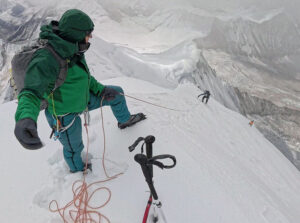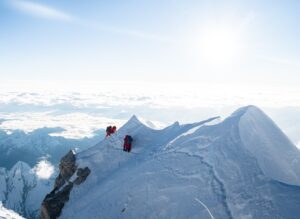Gesman Tamang belongs to the new generation of Nepali climbers: enthusiastic, skilled, and not afraid to think big. He had already gained a reputation as a mountain rescuer and guide when he became one of the climbers who led Nirmal Purja on his 14×8,000m Project Possible.
Gesman Tamang is from Nepal but he is not a Sherpa. He belongs to the Tamang ethnic group. Nor was he born to a family of climbers. He is the son of a farmer and the grandson of a Gurkha soldier.
First 8,000’er was Everest
Tamang learned the hard way. “I started working with trekking teams at 14,” he said. “At 20, I was hired as acook. At 22, I became a high-altitude porter and I summited my first 8,000’er at 26.”
That first 8,000’er happened to be Everest. He was with Seven Summit Treks and his job was to support a 72-year-old Chinese client.
“I was just lucky that everything went well,” said Tamang. “On the way down, I was sent up again to help in a rescue. At the time, I had very little knowledge of how to climb a mountain except for some tips I’d had from an uncle. When I returned to Kathmandu, I knew I had to learn all I could about mountaineering. I immediately started training in climbing and mountain rescue.”

Rappeling on Ama Dablam. Photo: Gesman Tamang
Soon, Tamang was routinely helping in rescues, especially those involving long lines. In spring 2021, for example, he and a Taiwanese client summited Annapurna without supplementary O2. Back in Base Camp, he immediately flew on a long-line search and rescue of three Russian climbers.
Tamang found them in Camp 4. He proceed to secure them so that they could be winched up to the helicopter. He was the last to be lifted out. At that moment, a strong gust hit the helicopter. It instantly plummeted 300m, throwing Tamang up above it and whiplashing him.
“The following morning,” he recalled, “I couldn’t move my neck and I was told to rest for two days. That is [all the time I had]. Right afterward, I was sent to a rescue on Dhaulagiri.”
Guiding Nims on six 8,000’ers
Tamang has summited Annapurna twice without O2 and was part of Alex Txikon’s team during Txikon’s first attempt on winter Everest. Yet his name is most closely associated with many of Nirmal Purja’s climbs on his 2019 Project Possible.

Annapurna was the first peak that Gesman Tamang (left) climbed with Project Possible. He summited without supplementary O2. Photo: Instagram
Tamang entered the project through Mingma David Sherpa, Nims’ partner. “I was on Annapurna, Kangchenjunga, K2, Cho Oyu, Manaslu and Shishapangma,” Tamang recalled.
“I’m happy I had this opportunity to guide for Project Possible because it gave me more guiding experience and plenty of Instagram followers. In the end, that is the best way I have to advertise as a guide. It helped build my confidence to start my own business. But Project Possible also made me realize how I don’t want to do business.”
Asked to elaborate, Tamang explained:
“I don’t want a company branded as elitist, suitable only for a certain type of person. I want an inclusive company that welcomes anyone who wants to climb or trek in Nepal.”

Gesman Tamang during a trip to Aconcagua during the Project Possible period. Photo: Sandro Gromen Hayes
For Nirmal Purja, Project Possible became a springboard to fame, but for Gesman Tamang, it was work.
“There was a group of us who were hired by Nims to guide him,” said Tamang. “My only condition was to climb only peaks that I had not summited before. So I was with him on all the peaks that were new to me, plus Manaslu [the only one Tamang had climbed before].”
On Cho Oyu, Purja obtained a special permit to enter China when it was closed to foreigners during the COVID pandemic. There, Tamang was the only guide supporting him.
“I carried part of his weight, cooked, and pitched the tent, as I would do with any other client.”

Gesman Tamang (right, in white) in a group photo during the premiere of Nirmal Purja’s Netflix documentary in Kathmandu. Photo: Gesman Tamang/Facebook
He also has great memories of the atmosphere among the team during the project. “While it lasted, Nimsdai made us feel all like brothers. He motivated us about all we could achieve.”
However, their professional relationship ended with Project Possible. For “personal and professional reasons”, Tamang declined Nims’ offer to join him on Winter K2.
” caption=”false”]
Winter Cho Oyu and new business
Instead, Tamang has both kept guiding and working toward personal goals. Last winter, he joined Gelje Sherpa to attempt a new route on the Nepal side of Cho Oyu. Despite the route’s difficulty, Tamang is sure it is doable. “The weather was the only reason we couldn’t do it this past winter,” he said.
This coming November, a number of Nepali climbers will return to Cho Oyu. Pioneer Adventure has confirmed that they will be there, and Nims’ Elite Exped, Mingma G’s Imagine Nepal, and Seven Summit Treks with Gelje Sherpa previously announced that they too would like to go and take clients with them.
“I’m not sure if I will be part of the next attempt due to my other projects,” Tamang said. This fall, Tamang will guide on Manaslu and Ama Dablam.

Gesman Tamang on the upper sections of Cho Oyu last winter. Photo: Instagram
Tamang is also starting his own outdoor clothing company, Ukalo, with partner Lauren Albert. So last spring, Tamang only guided Ama Dablam and devoted the rest of the time to his business and to rescues. Among other jobs, he helped retrieve the remains of Antonios Sykaris from Dhaulagiri’s upper slopes.
Helicopter over-use
About the soaring number of expeditions, climbers, and ascents (some climb several peaks in a season) Tamang has a live-and-let-live attitude. But he can’t forget his obsession with safety.
“I think it’s great that more people want to climb in Nepal, but I also think that there are more new climbers with little or no experience on big mountains because of the use of helicopters. In some cases, they are being dropped off at higher camps.
“In addition, they don’t all descend fully to base camp. It’s much more accessible and easier for new climbers now. It can be dangerous for someone to attempt 8,000m with no experience. But that is up to them and the company they are going with to take on those risks.”

A heavily laden Tamang guides on Annapurna. Photo: Instagram
It is uncommon for a guide to climb without oxygen, but “I did it on Annapurna in 2021 because my client wanted to go without O2, and he was strong and experienced. I did carry two bottles that either of us could use in an emergency. In fact, during the ascent, I met a climber who had tried without oxygen but it was not going well, and he offered me $1,000 for a bottle and a mask. I refused, of course –- that gear was a safety backup for me and my client.”
Asked if he’d like to climb not as a job but for the fun of it, Tamang replied. “Yeah, I would. I actually like to climb alone. Once I was sent to retrieve the body of a climber who had died at the South Summit [of Everest]. Since I was there, I decided to go to the summit first, on my own. It was great. Then I did the retrieval on the way back.”






